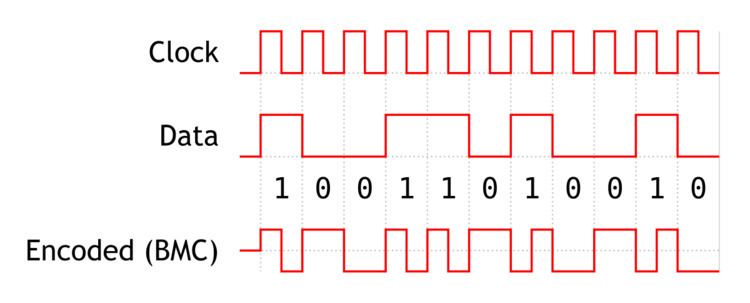 | ||
Differential Manchester encoding Scheme is a line code in which data and clock signals are combined to form a single 2-level self-synchronizing data stream. It is a differential encoding, using the presence or absence of transitions to indicate logical value. It is not necessary to know the polarity of the sent signal since the information is not kept in the actual values of the voltage but in their change: in other words it does not matter whether a positive or negative voltage is received, but only whether the polarity is the same or different from the previous one; this makes synchronization easier.
This encoding scheme is frequently called Differential Manchester since one way to describe it is applying Manchester encoding to differentiated data. Other names are biphase mark code (BMC) and Conditioned diphase.
Differential Manchester encoding has the following advantages over some other line codes:
These positive features are achieved at the expense of doubling the bandwidth -- there are two clock tics per bit period (marked with full and dotted lines in the figure). Every other clock tic, marked with dotted lines, there is a potential level transition conditional on the data. At the other tics, the line state changes unconditionally to ease clock recovery. One version of the code makes a transition for 0 and no transition for 1; the other makes a transition for 1 and no transition for 0.
Differential Manchester is specified in the IEEE 802.5 standard for token ring LANs, and is used for many other applications, including magnetic and optical storage. As Biphase Mark Code (BMC), it is used in AES3 and S/PDIF. Many magnetic stripe cards also use BMC encoding, often called F2F (frequency/double frequency) or Aiken Biphase. That standard is described in ISO/IEC 7811. SMPTE time code also uses BMC.
BMC is also the original "frequency modulation" used on single-density floppy disks, before being replaced by "double-density" modified frequency modulation.
